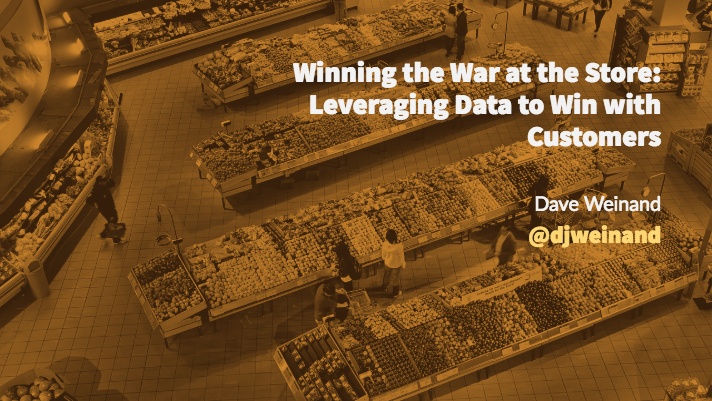Stores are as important as ever but their role has changed dramatically. To maximize the effectiveness of the store channel, grocers need to leverage the latest tools to mine hyper-local data. Learn from Albertsons, IBM, and Cherry Advisory as they detail what it takes to win the war in today’s stores.

Contrary to popular opinion, the store is just as important as it has ever been. The explosion that has occurred in eCommerce still only accounts for 3-4% of grocery sales and while this number will continue to grow, the store will remain the primary destination for shopping for the foreseeable future. This doesn’t mean, however, that role of the store is the same as it has been in the past. The shopper journey has become increasingly complex and this is causing the role of the store to completely change from where it was even 5 years ago. Complexity reigns as stores have gone from a single channel of commerce to an execution point for omni-channel digital sales and most importantly, an experience hub to meet the ever evolving needs of the customer.
The $64,000 question is ‘How can grocers best manage this complexity and stay competitive in today’s environment’? Much of the answer lies in the ability for grocers to better harness and manage data both at the corporate and at the local level. Incisiv’s Chief Insights Officer, Gaurav Pant, sat down with three experts to discuss how data can be used to drive better decisions and ultimately, provide a better experience.
Featured in This Exclusive Fireside Chat
![]() Gaurav. We know the role of the store is changing. What does that mean for Albertsons?
Gaurav. We know the role of the store is changing. What does that mean for Albertsons?
![]() Shereeen. At Albertsons we know our next big evolution is to create an experience for our shoppers. They no longer have to leave their home to get the lion’s share of their groceries so we know we have to create moments of inspiration to be relevant to our shoppers. This means holding things like cooking classes and floral arrangement classes so that we can create greater engagement. In addition, we see the growing importance of digital and leveraging both online and in-store digital tools to enable things like buy online, pick-up in store, curbside pickup and delivery.
Shereeen. At Albertsons we know our next big evolution is to create an experience for our shoppers. They no longer have to leave their home to get the lion’s share of their groceries so we know we have to create moments of inspiration to be relevant to our shoppers. This means holding things like cooking classes and floral arrangement classes so that we can create greater engagement. In addition, we see the growing importance of digital and leveraging both online and in-store digital tools to enable things like buy online, pick-up in store, curbside pickup and delivery.
“Shoppers no longer have to leave their home to get the lion’s share of their groceries so we know we have to create moments of inspiration to be relevant to our shoppers.”
Shereen Idnani
![]() Gaurav. The online channel is exploding and while grocery has been a laggard in terms of online sales as a percentage of revenue, it looks like that won’t last long. How does a store compete with the online channel?
Gaurav. The online channel is exploding and while grocery has been a laggard in terms of online sales as a percentage of revenue, it looks like that won’t last long. How does a store compete with the online channel?
![]() Dave. In today’s environment, stores and online should not compete with each other. They must complement each other. Stores need to focus on delivering what online can’t. Things like face-to-face interaction, emotional connections and the ability to read the consumer’s body language and react accordingly. And while for a long time the advantages of collecting user metrics and buying patterns sat with online, new tools and technologies are enabling a far greater degree of store level data collection and intelligence.
Dave. In today’s environment, stores and online should not compete with each other. They must complement each other. Stores need to focus on delivering what online can’t. Things like face-to-face interaction, emotional connections and the ability to read the consumer’s body language and react accordingly. And while for a long time the advantages of collecting user metrics and buying patterns sat with online, new tools and technologies are enabling a far greater degree of store level data collection and intelligence.
![]() Gaurav. There is no shortage of data. What types of data do you feel are most important to leverage?
Gaurav. There is no shortage of data. What types of data do you feel are most important to leverage?
![]() Melody. I like to say, data is like spices in the kitchen. All are useful, but not all can be used at once in a single dish. POS data can be effective in understanding demand but it doesn’t always tell the whole story. Tools now exist where retailers can gain access to hyper local data such as cultural makeup, weather, traffic, and events that could impact demand and create an opportunity for retailers to not only adjust inventory in real time but avoid out-of-stocks. The “inspiration” required for consumers to make the trip to the store will be different based on culture, income levels, and various other aspects that happen around the store. It’s now possible to get clarity into the needs and wants of the customers in the local area and this can make a big impact.
Melody. I like to say, data is like spices in the kitchen. All are useful, but not all can be used at once in a single dish. POS data can be effective in understanding demand but it doesn’t always tell the whole story. Tools now exist where retailers can gain access to hyper local data such as cultural makeup, weather, traffic, and events that could impact demand and create an opportunity for retailers to not only adjust inventory in real time but avoid out-of-stocks. The “inspiration” required for consumers to make the trip to the store will be different based on culture, income levels, and various other aspects that happen around the store. It’s now possible to get clarity into the needs and wants of the customers in the local area and this can make a big impact.
![]() Dave. This is critical in today’s environment. As we know, no two customers are alike and no two trips are alike. A customer making a trip in the lunch time on Tuesday will have a different set of requirements from a trip she makes on a Saturday afternoon for the family. Having hyper local data can enable a retailer to stock accordingly.
Dave. This is critical in today’s environment. As we know, no two customers are alike and no two trips are alike. A customer making a trip in the lunch time on Tuesday will have a different set of requirements from a trip she makes on a Saturday afternoon for the family. Having hyper local data can enable a retailer to stock accordingly.
“I like to say, data is like spices in the kitchen. All are useful, but not all can be used at once in a single dish.”
Melody Dunn
![]() Gaurav. What is Albertson’s data strategy?
Gaurav. What is Albertson’s data strategy?
![]() Shereen. We are taking a phased approach. We are utilising the “test, learn and optimise” approach that we’ve used online for the data in the store. In digital, it’s possible to create different variables to test customer experience tactics and we can make decisions based on the results. We are looking to apply the same level of data analytics to the store. The expectation isn’t that we’ll need to roll out a complex solution. We will run tests, learn from them, and optimise the platforms we have. But there is still a lot to be learned.
Shereen. We are taking a phased approach. We are utilising the “test, learn and optimise” approach that we’ve used online for the data in the store. In digital, it’s possible to create different variables to test customer experience tactics and we can make decisions based on the results. We are looking to apply the same level of data analytics to the store. The expectation isn’t that we’ll need to roll out a complex solution. We will run tests, learn from them, and optimise the platforms we have. But there is still a lot to be learned.
![]() Dave. I agree and often advise clients to test different type of experiences in different regions to learn about customer behaviour and then act upon it. I recommend a technique called decision modeling. This allows a retailer to break down an analytics project into the key variables such as what inputs are required, what insights are prioritized, what level of experience do the stakeholders need, etc. Once the objectives and processes are broken down, its possible to evaluate level of insights to make accurate predictions.
Dave. I agree and often advise clients to test different type of experiences in different regions to learn about customer behaviour and then act upon it. I recommend a technique called decision modeling. This allows a retailer to break down an analytics project into the key variables such as what inputs are required, what insights are prioritized, what level of experience do the stakeholders need, etc. Once the objectives and processes are broken down, its possible to evaluate level of insights to make accurate predictions.
![]() Gaurav. How do retailers need to go about maximizing their data strategy to win in the store?
Gaurav. How do retailers need to go about maximizing their data strategy to win in the store?
![]() Shereen. The focus needs to be to change the way organizations views their stores overall vs trying to solve a single problem in the customer's buying journey. The behavior across demographics is changing. Younger consumers are more comfortable shopping online. The challenge is to create a reason for the younger shopper to visit the store. A big part of us solving that challenge is understanding and accepting we need to include the in-store personnel in the process with the teams that develop the solutions. Store associates can be the brand ambassadors that can help with the change and as long as we provide proper training they will contribute to the experience and help with the data collection. However, it cannot be the same person who is ringing up the customers. We believe in the concept of brand ambassadors and while it’s a challenge with the constant drive for efficiency, we believe it is difficult to achieve as stores have to be cost efficient. The customer buying journey is not just for customers but retail organisations and the individuals who are responsible for the day-to-day activities in the store.
Shereen. The focus needs to be to change the way organizations views their stores overall vs trying to solve a single problem in the customer's buying journey. The behavior across demographics is changing. Younger consumers are more comfortable shopping online. The challenge is to create a reason for the younger shopper to visit the store. A big part of us solving that challenge is understanding and accepting we need to include the in-store personnel in the process with the teams that develop the solutions. Store associates can be the brand ambassadors that can help with the change and as long as we provide proper training they will contribute to the experience and help with the data collection. However, it cannot be the same person who is ringing up the customers. We believe in the concept of brand ambassadors and while it’s a challenge with the constant drive for efficiency, we believe it is difficult to achieve as stores have to be cost efficient. The customer buying journey is not just for customers but retail organisations and the individuals who are responsible for the day-to-day activities in the store.
![]() Gaurav. If retailers do subscribe to the concept of brand ambassadors, how do you get associates to focus on things that are important with the help of analytics?
Gaurav. If retailers do subscribe to the concept of brand ambassadors, how do you get associates to focus on things that are important with the help of analytics?
![]() Melody. It’s necessary to reward the actions taken from the insights, as stores tend to stick to their historical way of doing things. Store associates should be allowed to take actions based on the insights provided to them.
Melody. It’s necessary to reward the actions taken from the insights, as stores tend to stick to their historical way of doing things. Store associates should be allowed to take actions based on the insights provided to them.
![]() Dave. The focus should also be on hiring the right people that have some interest in the environment. For example, Roadrunner Sports hires runners as their associates. They are passionate about what they are selling and engage customers who tend to be fellow runners. They can nerd out about running with their customers. For a grocery store, the same can be said about wine bars. If the store associates know their wines, they are able to build an engaging conversation with the customers. It encourages customers to go to the store and talk to the associates.
Dave. The focus should also be on hiring the right people that have some interest in the environment. For example, Roadrunner Sports hires runners as their associates. They are passionate about what they are selling and engage customers who tend to be fellow runners. They can nerd out about running with their customers. For a grocery store, the same can be said about wine bars. If the store associates know their wines, they are able to build an engaging conversation with the customers. It encourages customers to go to the store and talk to the associates.
![]() Gaurav. What are the impediments that stops retailers from better leveraging hyper-local data?
Gaurav. What are the impediments that stops retailers from better leveraging hyper-local data?
![]() Shereen. The challenge remains in figuring out the path to get there. There are so many priorities in the stores today it can be hard to focus on strategic issues that don’t involve keeping the lights on, keeping the register running. However, if grocers don’t better leverage data to address the needs of their local stores, people will stop coming. A cultural shift is required to recognise the importance of leveraging analytics and we are undergoing that shift now at Albertsons. It is also important to not try to bite off too much. That’s why we are taking a phased approach to our analytics strategy. The data is very complex and we want to get it right. Finally, it’s important for customers to be excited about the new experiences being offered by the store. Albertsons is building their own analytics team and also partnering with players like IBM to build upon our phased approach to improve customer experience.
Shereen. The challenge remains in figuring out the path to get there. There are so many priorities in the stores today it can be hard to focus on strategic issues that don’t involve keeping the lights on, keeping the register running. However, if grocers don’t better leverage data to address the needs of their local stores, people will stop coming. A cultural shift is required to recognise the importance of leveraging analytics and we are undergoing that shift now at Albertsons. It is also important to not try to bite off too much. That’s why we are taking a phased approach to our analytics strategy. The data is very complex and we want to get it right. Finally, it’s important for customers to be excited about the new experiences being offered by the store. Albertsons is building their own analytics team and also partnering with players like IBM to build upon our phased approach to improve customer experience.
![]() Dave. The foremost impediment is deciding to get started. What most people struggle with is that there are so many opportunities, retailers have a hard time prioritizing what to do first. Retailers should implement a decision modeling approach as it can help them to create the roadmap they need to ensure a successful project.
Dave. The foremost impediment is deciding to get started. What most people struggle with is that there are so many opportunities, retailers have a hard time prioritizing what to do first. Retailers should implement a decision modeling approach as it can help them to create the roadmap they need to ensure a successful project.
Retailers also need to understand the customer experience that they are trying to drive for their brand. Most of the retailers are following a “me-too” strategy. Retailers are implementing things just because everyone else has it. Groceries are trying to implement curbside delivery and scan and go options because everyone else has it, which is not a good reason to do it. Retailers need to look at their customers, their market position, their experience that they want to drive with their customers and then decide if they want to offer it. The hard part about it is that retailers can’t be the last one to implement something that has become the baseline expectation with the customers. Eg BOPIS option.
"Retailers need to understand the customer experience that they are trying to drive for their brand."
Dave Cherry
![]() Melody. Retailers need to work with a technology partner to guide them to select the right capability that is going to help them improve customer experience. Data has a huge role to play, but retailers need to look beyond their own data, Navel Gazing :). Not to follow a me-too approach, but retailers need to be aware of what their competition is doing.
Melody. Retailers need to work with a technology partner to guide them to select the right capability that is going to help them improve customer experience. Data has a huge role to play, but retailers need to look beyond their own data, Navel Gazing :). Not to follow a me-too approach, but retailers need to be aware of what their competition is doing.
To view the complete recording of the webinar - Winning the War at the Store: How to Generate Customer Intimacy with Local Data, Register Here.
For more information on IBM Metropulse visit ibm.biz/hyperlocal-metropulse.


 Gaurav Pant
Gaurav Pant 
 Shereen Idnani
Shereen Idnani  Dave Cherry
Dave Cherry  Melody Dunn
Melody Dunn 

